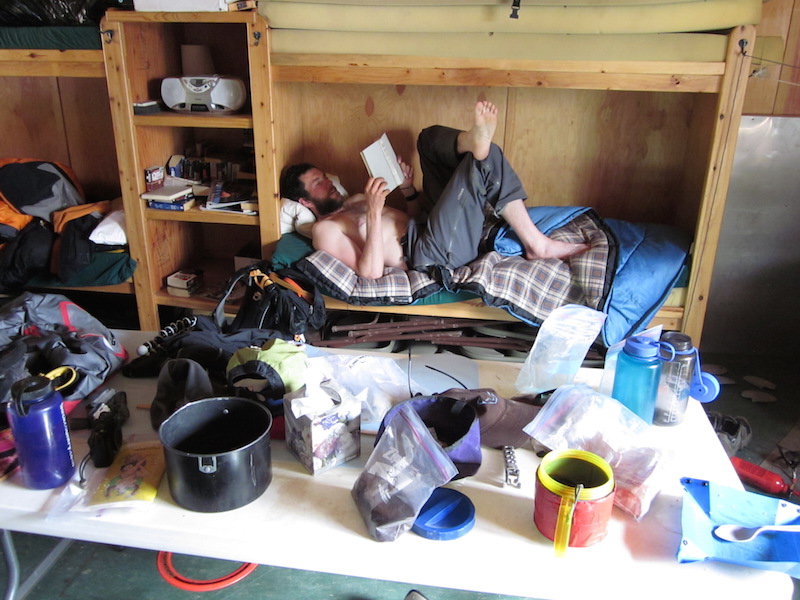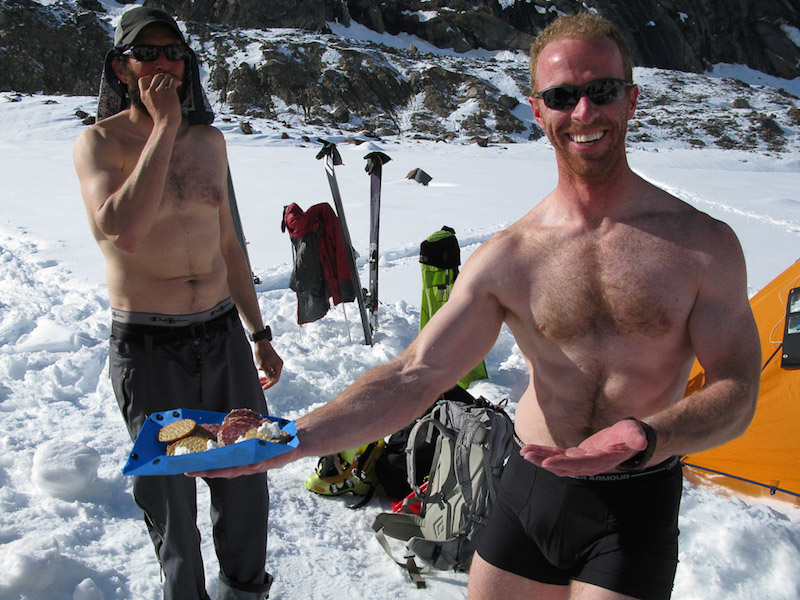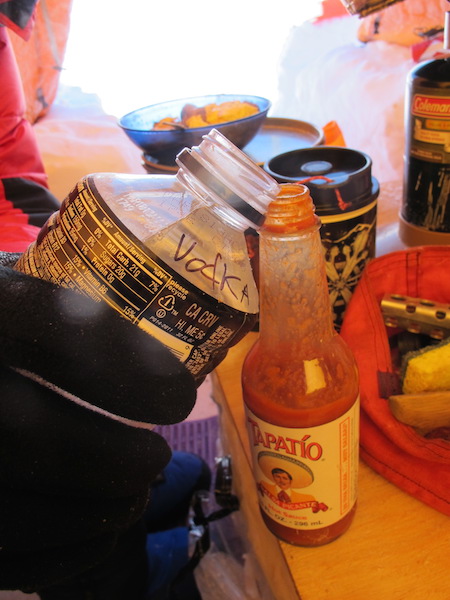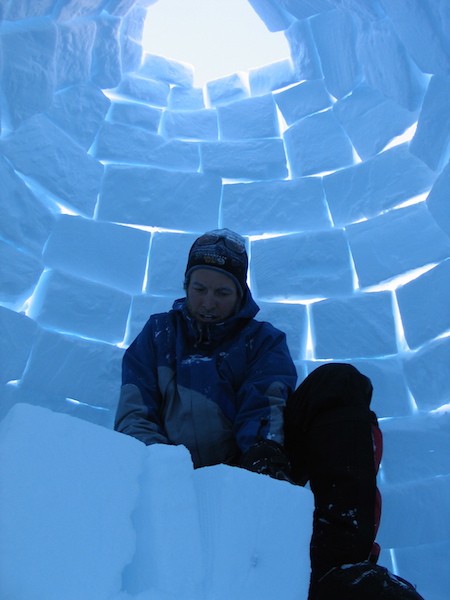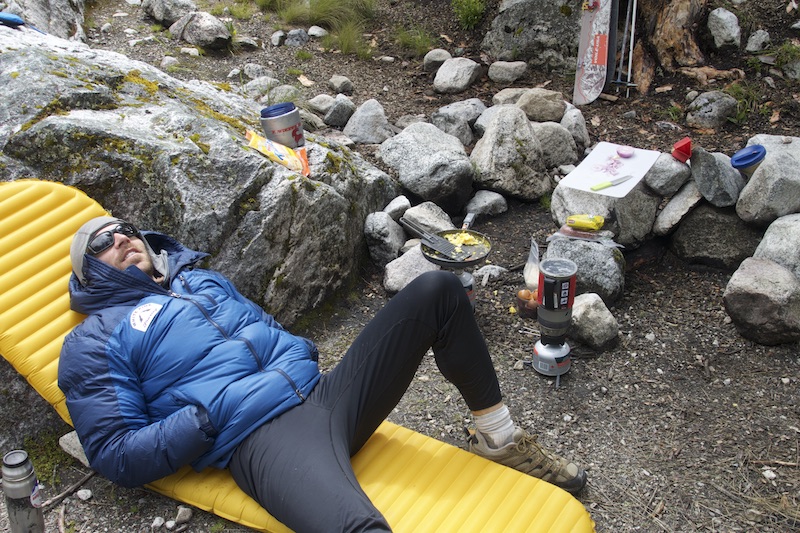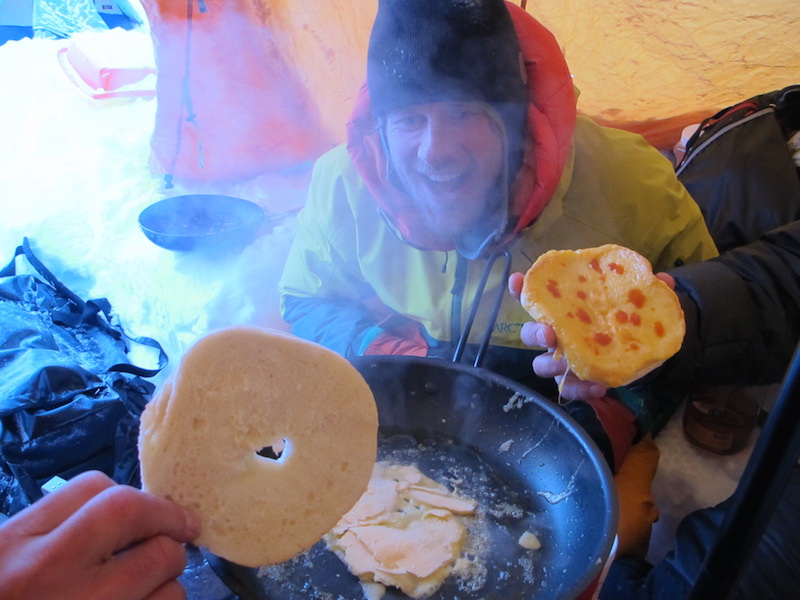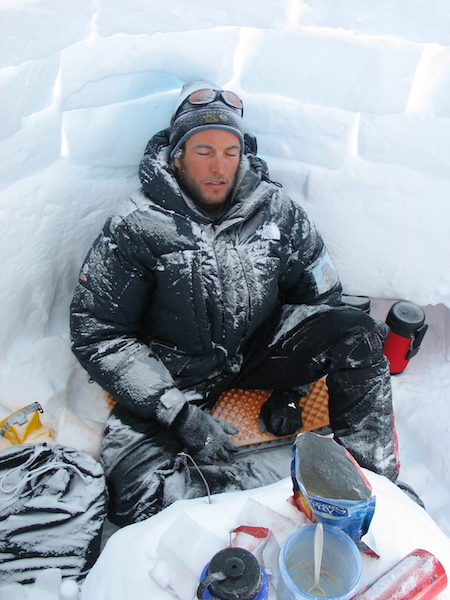The new Ascent Magazine is out. Look for it at your local gear or coffee shop in the western states. This is the final issue of the season and with expeditions and spring trips on the way I put together a little piece on managing down time.
It would be interesting (maybe even depressing) to know the total number of days I’ve spent skiing versus not skiing on the thirty plus hut trips and skiing expeditions I’ve been on over the past seventeen years. There was the time I spent 8 straight days waiting out a storm in a dome tent outside of Haines. Or, the RV trip to Thompson Pass where we only managed to squeak out four days of skiing in the entire three weeks. And I’d rather not bring up a trip to Peru where it rained and snowed so hard that we never even made one ski maneuver. Downtime isn’t always a bad thing though, in fact it’s quite nice with the right folks, proper planning and decent accommodations. Here are some tips for dealing with the inevitable and becoming a master at the art of chill.
(Passing the time by reading for two days at a hunting lodge in Alaska after skiing in the Revelation Mountains. Photo= Jim Harris)
Reading- Some ski trips really should just be relabeled as “reading camp”. This is hands down the best way to pass time (like days at a time). Good reading material is key, so choose your books wisely. In fact, bring a few. I’ve blown through entire novels just getting to the ski destination. Also, not a bad idea to consult with teammates about what they are bringing to see if a swap would be amicable. Or, to make sure you’re not both bringing the same book, which miraculously happened to Ben Peters and I when we both showed up with “Infinite Jest”, which is infinitely long and neither of us actually finished despite 9 or 10 down days. Audio books are excellent and hands free, which is nice in cold temps and you don’t have to hold the book and turn pages with cold fingers. The Kindle or similar e-readers are very good choices. They hold battery life for very long periods and can contain entire libraries.
(Courtney Phillips and myself airing things out and enjoying some snacks after a big day. Photo= Jim Harris)
Cooking- Preparing food is a great activity that’s fun, boosts morale, and kills time. Plus you get to eat it! If you’re not laying it all out for a 100 mile traverse, or ultra-light crossing of a range and you have the chance, bring good food. I usually bring two categories of food. Heavy food (real food) for down days at camp and lightweight food (packaged, dehydrated) for being on the move and traveling light. Good food doesn’t have to be heavy, but have things on hand that you actually like and that require some preparation. The ten minutes to boil water for Ramen isn’t as satisfying as chopping up veggies, browning sausage, or grilling quesadillas. Bring along a variety of ingredients so you can mix things up and get creative. Two of my favorite discoveries are Cheese Spinners that come from placing cheese into a hot frying pan, then place a bagel on top and sop up the cheese by twisting the bagel until it’s all absorbed and becomes one with the bagel. Add toppings to make it a pizza. Another gem is whiskey and snicker pancakes, which is exactly what it sounds like. This was discovered near the end of a trip by just mixing leftover food and beverage into the batter. Great discovery! Damn, I’m hungry just thinking about this.
(Killing time in the kitchen. Mark Holbrock trying to thaw out the frozen hot sauce by adding Vodka? Photo= Andrew McLean)
Drinking- Tea, coffee, hot cocoa, matte, soup, etc are all key! You can burn hours of time (and lots of fuel) brewing up. It’s warm and hits the spot and keeps you hydrated unless you go to heavy on the alcohol. But don’t be shy, just a nip of fireball, or whiskey goes a long way. Having a good liquor cabinets allows for fun cocktail mixtures and can lighten the mood. (“Drinking it blue” is a myth, but drinking till you black out is real)
(We decided to build an igloo on a down day at 14,000 ft camp on Denali. Cutting the final blocks on what turned out to look more like a beehive. Photo= Matt Turley)
Activity- Move around! Our tendency when it’s cold and dark and stormy is to tighten up, shrink, move inward and become still. Blowing through days in your sleeping bag is fine, but moving is better. It’s better for the body, mind and soul to move, sweat and stretch. Start doing things, this could be re-building your kitchen in the cook tent, digging out a new shitter, building bigger snow walls around the tents, etc. Go for a short ski tour using flags to mark your way and then do laps. Trapped for a day in a hut in New Zealand we set up an interval circuit of push up, pull-up, jumping jacks and squats. Yoga is a great way to stay limber. Get crafty, make repairs to gear or clothing. Dig a deep pit in the snow and do pull-ups on your skis (thanks Alex Lowe). Take a whore bath, just heat up some hot water and or use sanitizer to clean all the clammy parts. This can be refreshing even if you just slide right back into dirty clothes.
(Matt Primomo deals with his inner demons after coming down with a stomach bug in Peru. We camped in the rain for three days and then bailed on our objective.)
Drugs- Just say yes! Mind altering substances are excellent backcountry companions. Some of my most meaningful conversations have been with the snow. More bonus points because unlike alcohol they don’t weigh much, they’re not very bulky and they’re great fun without the hangover.
(Garrett Grove displays genuine glee at discovering the “cheese spinners”.)
Games- Board games are interactive, keep the mind alert and are easy to pack in. However, make sure you’re not going head to head with overly competitive people. I’ve seen some heated Scrabble that almost went to fist-to-cuffs and that was with my sweet brother! Ice axe toss for distance and or accuracy is always fun. A frisbee is light and can be incorporated with ski poles into many drinking games.
Writing- Keep a journal, sure nobody but you wants to read about your lame trip where you sat in a tent and journaled, but it’s a good way to document the trip and exercise the medulla oblongata. I like creating lists. Such things as items you wish you had brought, items you bought and didn’t use. Make notes of gear repairs, or changes you want to make to your kit. Use a notepad so you can draw, it’s much more satisfying than jotting it on your iphone or mobile device.
(Trying to find my happy place. Photo= John Colter)
Mentality- The mental game can be the most difficult, but most important part of the waiting game. I’m going to lay some zen new age shit out there. I’ve been told and found it to be true that the only suffering is fighting the reality around you. If your plane is having mechanical difficulty and you have to blow three of your expedition days in the strange town of Iqaluit on your way to Baffin Island when you should be skiing, then so be it. This is part of the adventure! Being at war with it, or thinking it should be another way only creates misery. Go play with the locals, kite on the fjords and join in. Fight reality and you always lose. Be willing to laugh at yourself and the ridiculousness of the situations we willingly pay large sums of money and risk life and limb to put ourselves in.
So, pick the right season, give yourself enough time and your odds are good that you’ll get some skiing in on your next yurt trip, or skiing expedition. But, remember the odds are just as good that somewhere along the way you’ll end up losing luggage, or getting jet-lagged, or being ill, or completely shut down by weather. There will be down days, be prepared to enjoy them.

